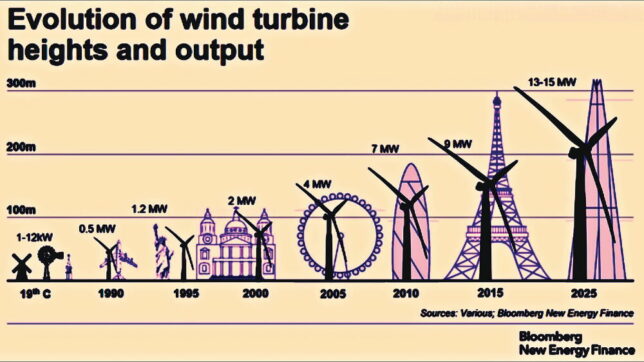Green Watch
Italian Energy Giant Invades America: Eating Up the Environment
 To grasp the enormity of Enel’s occupation of America, imagine solar panels and wind turbines covering all of Yosemite National Park or both Great Smoky Mountain National Park and Rocky Mountain National Park put together. Credit: Chic Bee. License: https://shorturl.at/dBPWY.
To grasp the enormity of Enel’s occupation of America, imagine solar panels and wind turbines covering all of Yosemite National Park or both Great Smoky Mountain National Park and Rocky Mountain National Park put together. Credit: Chic Bee. License: https://shorturl.at/dBPWY.

Enel: An Italian Energy Giant Invades America (full series)
Eating Up the Environment | Trespassing Against the Osage Nation
Virtue Signaling | The Cheapest Way to Make Expensive Electricity
Summary: Enel is an Italian firm that that has filled enough of America with wind turbines to cover two of the nation’s big national parks. But the intermittent, weather dependent power Enel generates from all those turbines isn’t enough to rival the carbon-free electricity from a nuclear power station that occupies less than 6.5 square miles—the size of a big residential subdivision development. Enel does all this because American politicians value virtue signals more than power production. With the Inflation Reduction Act, U.S. taxpayers are teed up to pay even more for sanctimony being sold as electricity.
Near the end of last year, the Wall Street Journal reported that Enel, referred to by the newspaper as an “Italian energy giant,” was “readying a massive solar-manufacturing push in the U.S.” According to the Journal, nearly $400 billion in federal climate pork unleashed by the so-called Inflation Reduction Act was inspiring the solar building boom.
“Massive” and “giant” are already excellent adjectives for the landscapes and tax dollars that get gobbled up when weather dependent power comes to town.
Eating Up the Environment
By the time that Wall Street Journal report was published, Enel already had at least 24 wind and solar energy projects operating across nine U.S. states, on a combined 1,270 square miles of real estate. Most of that was Enel wind facilities.
To grasp the enormity of Enel’s occupation of America, imagine solar panels and wind turbines covering all of Yosemite National Park or both Great Smoky Mountain National Park and Rocky Mountain National Park put together.
From that huge hunk of America, Enel generated almost 20.9 terra watt hours (TWh) of electricity in 2022. A TWh is roughly enough to power 70,000 American homes for a year, so Enel’s output from those 24 facilities was hypothetically enough to electrify almost 1.5 million homes.
That’s a horrible waste of the environment compared to energy systems not dependent on the weather.
During 2022, according to the U.S. Department of Energy, Arizona’s Palo Verde nuclear power plant kicked out more than 31.9 TWh of carbon-free electricity from just a 6.4 square mile site near Phoenix. This was enough to juice up more than 2.2 million homes, or 700,000 more than all of Enel’s 24 weather-dependent power facilities.
Instead of needing the combined acreage of two large national parks, Palo Verde operates on a plot of land about the size of a large subdivision.
Burning coal in 2022, Alabama’s James H Miller Jr. power station produced almost 20.9 TWh of electricity. The Alabama powerhouse equaled the energy production on Enel’s 1,270 square miles on a little more than one square mile.
And the West County Energy Center, a natural gas power plant in Florida, generated 19.5 TWh on just one-third of a square mile in 2022. This was enough to power almost 1.4 million homes, just 100,000 shy of Enel’s 24 energy projects put together, but from a tiny spot roughly the size of a large golf course.
The landscape gobbling numbers of wind and solar energy are not unique to Enel.
A 2020 report from the center-left Brookings Institution combined all land-use factors necessary to produce electricity, including mining of materials, mining and transportation of fuels, power distribution lines, and more. The report concluded that in overall energy density, coal, nuclear, and natural gas are far superior to wind and solar:
Wind and solar generation require at least 10 times as much land per unit of power produced than coal- or natural gas-fired power plants, including land disturbed to produce and transport the fossil fuels. Additionally, wind and solar generation are located where the resource availability is best instead of where is most convenient for people and infrastructure, since their “fuel” can’t be transported like fossil fuels. Siting of wind facilities is especially challenging. Modern wind turbines are huge; most new turbines being installed in the United States today are the height of a 35-story building. Wind resources are best in open plains and on ridgetops, locations where the turbines can be seen for long distances.
Enel is dismissive of the landscape blight caused by the towering turbines. “Each turbine takes up less than half an acre,” proclaims a FAQ on the firm’s website.
This was posted as an evasive reply to the question “How much land does a wind farm occupy?” [emphasis added]
Another Enel FAQ asks: “Does wind energy receive energy incentives?”
“Yes,” begins another dodgy answer. “All forms of energy, including oil and gas, coal, nuclear, and renewables, receive federal support.”
In September 2023, using 2022 federal subsidy statistics from the Department of Energy, journalist Robert Bryce calculated that wind energy received 19 times more subsidy dollars per unit of power produced than coal, 31 times more than natural gas and oil, and a whopping 70 times more than nuclear. Solar was even worse, according to Bryce, receiving 302 times more than nuclear.
With that perspective, Enel applying an “everybody is doing it” context for a comparison of wind and nuclear subsidies is akin to claiming that a high school football team has a shot at beating the Super Bowl champion. It is functionally a lie.
In the next installment, the Osage Nation defeats Enel in federal court for illegally constructing wind turbines on its land.



